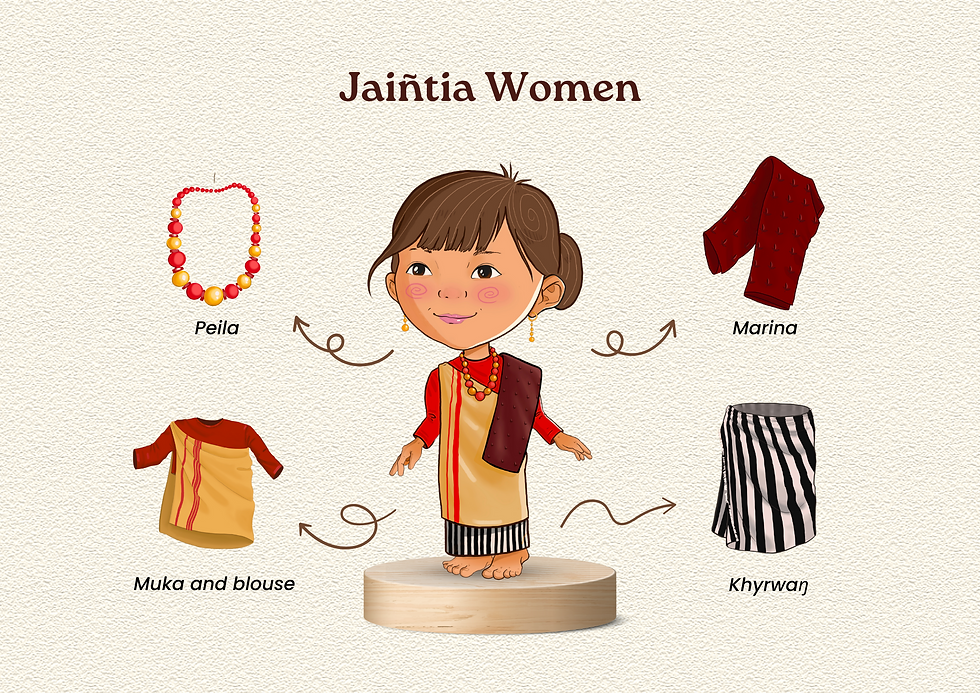Threads of Heritage: The Cultural Significance of Jaiñtia Traditional Garments
- sauramandalain
- Mar 19
- 4 min read

“As a child, I was fascinated by the sight of people wearing traditional garments like the Muka and Thoh Saru, especially during the Chad Sukra festival. At the time, I believed only non-Christian communities wore these clothes. Curious, I once asked my father about this. His response was enlightening:
‘The Muka and Thoh Saru are not just festival attire; they symbolize the deep pride of the Jaiñtia people. When we wear these garments, we make a silent yet powerful statement about our identity. Without uttering a word, people recognize that we are from Jaiñtia.’
What I once saw as ordinary garments became symbols of cultural heritage, unity, and pride. Today, I realize that wearing traditional clothing is not only about celebrating festivals but also about embracing and honoring our roots.”
-Mayanka Chyrmang, TFFP Project Associate
In the northeastern state of Meghalaya, the Khasi, Jaiñtia, and Garo tribes each bring their own unique cultures and traditional clothing. The Jaiñtia community consists of two primary subgroups: the Pnar Jaiñtia, who inhabit the highlands, and the War Jaiñtia, who reside in the border areas. Despite geographical and linguistic differences, both groups share a deep connection to their heritage, with traditional attire playing a crucial role in preserving their identity.
Traditional Garments: A Symbol of Pride and Culture
In the Jaiñtia community, clothing is more than just fabric. As it is with all tribal communities, traditional clothing carries a lot of historical significance and embodies a deep connection with nature and society. Traditional attire is worn during festivals, religious ceremonies, and important community gatherings, with vibrant colors and patterns honoring ancestors and customs.

Jaiñtia Women:
Yusem Muka: A wrap-around garment made from Muga yarns, featuring artistic designs with two parallel lines on the front as stripes.
Blouse: A silk blouse worn under the Muka, adding elegance and complementing the flowing drape.
Thoh Saru: Another wrap-around garment, traditionally worn around the waist, representing both grace and cultural pride.
Jewelry: Women wear a traditional gold-and-red necklace known as Peila, which adds grandeur to the outfit.
Marina (Speiñ Khlieh): A traditional shawl draped around the neck and shoulders.

For Men:
Yusleiñ: A dhoti-like garment worn on special occasions, wrapped around the waist.
Butoi (Waistcoat): A traditional coat worn over the upper body, sometimes adorned with symbolic patterns.
Yuspong: A turban made from plain white cotton cloth or ryndia, worn as a mark of respect during religious ceremonies and community events.
Accessories: Like women, men also wear jewelry such as the Peila.
Ryndia Tlem: A cotton or Eri silk shawl draped over the shoulders or upper body.
Influence of Modern Fashion on Traditional Garments
In recent years, modern fashion trends have influenced traditional Jaiñtia attire. Younger generations blend contemporary styles with traditional garments, creating hybrid outfits that fuse modern aesthetics with cultural symbolism.
For example, women now pair the Merina shawl with blouses or crop tops, while men wear modern shirts under their Bitoi (traditional attire for men), and some choose not to wear the Yuspong turban during festivals. These changes allow the Jaiñtia people to maintain cultural identity while adapting to evolving fashion trends.
Fashion historian Leslie Holmes states, "Traditional garments, with their deep-rooted stories and aesthetics, continue to inspire and shape modern fashion trends. Fashion is not just about what we wear; it’s a canvas through which we express our individuality and celebrate the rich tapestry of cultures that make up our world."
The TFFP Books: Bridging Past and Present
"TFFP books bring traditional garments to life through engaging illustrations, helping children connect with their cultural heritage. The visual representation allows them to understand the significance of these garments, ensuring that they are not just relics of the past but living symbols of identity."
-Wa-I-Sa, TFFP translator, Jaiñtia Hills
The TFFP Garment Series serves as a gateway for children to explore their heritage. Through engaging illustrations and narratives, these books introduce children to the traditional garments of the Khasi, Garo, and Jaiñtia communities, fostering cross-cultural understanding.
Wa-I-Sa notes,
"The TFFP Garment Series strikes a balance between past and present, reviving and replenishing traditions. By weaving traditional clothing into stories, these books create a bridge between generations, preserving heritage for a brighter tomorrow."
Embracing one’s culture through traditional garments goes beyond mere attire. As highlighted in The Forgotten Folklore Project (TFFP) books, traditional clothing plays a vital role in shaping identity, especially for younger generations. The TFFP contextualizes cultural stories for children, integrating the rich heritage of the people of Meghalaya into educational materials.
The traditional attire of the Jaiñtia community is more than just clothing; it is a living expression of their identity, history, and values. By continuing to wear and cherish these garments, the Jaiñtia people uphold the customs and artistry passed down through generations, ensuring that their cultural heritage remains vibrant and relevant. In an ever-changing world, such traditions serve as a powerful bridge between the past and the present, fostering a sense of belonging and continuity. Efforts to document, revive, and celebrate these garments not only honor the craftsmanship of ancestors but also inspire younger generations to take pride in their roots. As traditional attire finds its place alongside contemporary influences, it becomes a symbol of resilience, adaptability, and cultural pride. It is a testimony that heritage can evolve without losing its essence. Through this ongoing commitment to preserving and wearing traditional garments, the Jaiñtia people reaffirm the richness of their legacy, keeping it alive for future generations to appreciate and embrace.
Written by Mayanka Chyrmang, Edited by Mahima Sinha




Comments